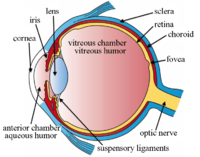
Photo from wikipedia
Introduction Treatment of juvenile idiopathic arthritis (JIA)-associated uveitis necessitates the use of long-term corticosteroids or immunosuppressive agents, each of which poses their own significant side effect profile. Initial treatment requires… Click to show full abstract
Introduction Treatment of juvenile idiopathic arthritis (JIA)-associated uveitis necessitates the use of long-term corticosteroids or immunosuppressive agents, each of which poses their own significant side effect profile. Initial treatment requires intensive topical glucocorticoids, with a step-up approach employing immunosuppressive agents for those cases with poor response or high-risk complications such as macular oedema. To date, there is minimal evidence to support a specific approach to such complicated subgroups. We present the first case to successfully employ the 0.19 mg fluocinolone acetonide implant (ILUVIEN ® , Alimera Sciences, Hampshire, UK) as a novel device for prolonged intravitreal administration of disease-modifying agents for patients with JIA complicated by uveitis. Methods This retrospective case report describes a 20-year old woman diagnosed with oligoarticular JIA complicated by chronic uveitis and associated cystoid macular oedema (CMO). Considering factors including the patient’s non-compliance, age, lens status, non-steroid response, and good response to short-term intravitreal steroid therapy, the 0.19 mg fluocinolone acetonide intravitreal implant was deemed an appropriate step-up treatment option. Results At 12-month follow-up, the left eye (OS) showed an improvement in visual acuity to 6/15 − 1 from 6/60 + 1 (0.42 from 0.98 logMAR) (pre-insertion) and a reduction in central retinal thickness (CRT) of 199 μm from 471 μm. The right eye (OD), treated 10 months later, showed an improvement in visual acuity to 6/7.5 from 6/24 − 1 (0.10 from 0.56 LogMAR) and a reduction in CRT of 327 μm 6 months after treatment. Conclusion In this case, the 0.19 mg fluocinolone acetonide implant provided safe and effective long-term treatment of JIA-associated uveitis and secondary CMO. This potentially offers an alternative approach to complex cases that show good response to short-term corticosteroid use.
Journal Title: Ophthalmology and Therapy
Year Published: 2021
Link to full text (if available)
Share on Social Media: Sign Up to like & get
recommendations!